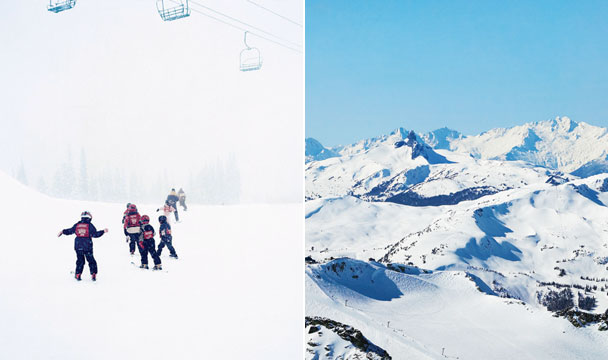Somehow the fact that Whistler has the greatest vertical drop—5,280 feet—of any ski area in North America didn’t really sink in until I was peering nervously down the high-altitude trail called Burnt Stew. I had heard that one of the best things about this resort is that “experienced beginners” like me aren’t corralled on slushy or skied-out lower slopes but can instead enjoy the whole mountain like everyone else. It sounded terrific, but this looked like something out of Downhill Racer. I felt a brief stab of longing for the bunny hill, and then, before I had a chance to think twice, pointed my skis in the right direction and pushed off.
Just over 40 years ago, there was nothing here. Blizzards caused by damp Pacific air reaching the snowy crags of the Coast Mountains in British Columbia reliably dumped heavy snowfall on this secluded glacier-carved valley north of Vancouver. A few hardy locals would hike into the backcountry around London Mountain to ski steep powder faces, but that was about it. Summer was the high season, and all the action centered on rustic lakefront lodges crammed with fishing rods, canoe paddles, and enthusiastically daubed watercolors. Then, in 1965, one year after the area got its first paved road and electricity, a few savvy businessmen intent on hosting the Winter Olympics built the first T-bars on London. The mountain soon bore the more evocative name Whistler, after the shrill cry of the marmots that inhabit it, although I’ve yet to meet anyone who has ever heard (or seen) one.
Even today—when condominiums in Whistler Village are among Canada’s most expensive and the golden rings of the 2010 Winter Olympics have been grasped tight—the resort remains relatively laid-back and glitz-free. All you need to do is look up at Whistler and its massive sister mountain, Blackcomb, to realize that the civilized veneer over this brooding expanse of wilderness is as thin as birch bark.
Snowfall averages 396 inches a year, and more than 30 lifts and 200 marked trails cover about 8,000 acres of skiable terrain. The options are a little overwhelming. After your chair ascends through rain, fog, and clouds—the low elevation and proximity to the ocean make for plenty of wet weather—into the glory of a sunny springtime day, it can be hard to figure out where to go first. That’s where the mountain hosts come in. These volunteers are ever willing to answer questions (“Where’s the best secret stash of powder?”) and give directions or complimentary tours. When I asked a senior host why he’d been volunteering for 40 years, his answer was as forthright as the look in his eyes. “I just love the mountain,” he said.
I discovered that Whistler is famous for its wide-open alpine bowls (natural formations shaped like catchers’ mitts) full of untouched powder, whereas Blackcomb has more tree runs, glaciers, and narrow, steeply pitched couloirs, or chutes, that an expert skier will simply drop into without a moment’s hesitation. No wonder the place speaks to Europeans fleeing the snowless Alps; at this writing, there are 31 feet of snow on the ground, and a quick peek at Whistler’s webcams tells me more is coming down hard and fast.
As tempting as it was to tackle one mountain before lunch and the other one after, a hotel concierge I shared an energy bar with mid-mountain passed along some local wisdom: Taking the lifts between the mountains wastes precious skiing time, so pick one mountain for the day and stay with it. “And if you’re on Blackcomb,” he called over his shoulder as he headed off, “Go to the Crystal Hut and have the waffles for lunch!”
It wasn’t until I was halfway down Burnt Stew that I realized I wasn’t frowning with concentration anymore. I was, I discovered, having a wonderful time. In fact, I was flying, in a casual, cruisey kind of way that was entirely new to me. The long, winding, beautifully groomed run is more inspiring than intimidating; there are no unnervingly sharp turns or traffic-clogged intersections to speak of; and the views from above the tree line are panoramic. I ended up down in the village winded, exhilarated, and starving.
Architecturally speaking, Whistler Village could be described as an alpine Disneyland, albeit one with music from a Warren Miller video blaring out of almost every open door. But the people who work in the shops and restaurants that line the meandering pedestrian plaza are so nice that poking fun just seems mean-spirited. Most are under 30, enviably fit, and glowing with health. “I work to play,” explained one waiter-snowboarder from Ontario. “In the summer, I’m a wilderness guide on the Great Lakes.”
Whistler’s best restaurants leave resort culture behind and instead focus on the extraordinary Pacific Rim bounty you see in Vancouver and Seattle. Dinner—a dozen impeccable oysters, say, followed by wild Arctic caribou loin, a splendid B.C. red, and one of the region’s glorious ice wines to finish—necessitates a stroll afterward down a cobblestone lane. Lamplight and lazily drifting snowflakes work their magic, turning the absurdly quaint village into something mysterious and beautiful. One evening, a leaflet taped to a storefront caught my eye. “Ziptrek Ecotours,” I read. “Zip through the treetops of ancient rainforest.” Rainforest? Zipping? I was hooked.
The next morning, I braced myself for disappointment, thinking I might be in for a scaled-up kiddie ride. But no. After being outfitted with harness and helmet, our small group of thrill-seekers bounced up the valley between Whistler and Blackcomb in a burly little Sno-Cat, then hiked above the torrent that is Fitzsimmons Creek during the spring thaw. Our two guides seemed extremely alert to everything going on around us. “Bears are waking up,” one explained. Surrounding us was all that remains of the coastal temperate rainforest that once rippled in a lush ribbon from California to Canada.




 Pinterest
Pinterest






